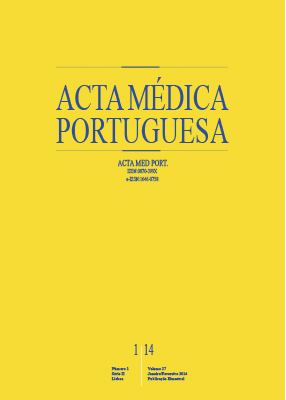Fractional Exhaled Nitric Oxide in Monitoring and Therapeutic Management of Asthma
DOI:
https://doi.org/10.20344/amp.2371Abstract
Introduction: Asthma is a chronic respiratory disease characterized by hyper-responsiveness and bronchial inflammation. The bronchial inflammation in these patients can be monitored by measuring the fractional exhaled nitric oxide. This study aims to determine fractional exhaled nitric oxide association with peak expiratory flow and with asthma control inferred by the Global Initiative for Asthma.Material and Methods: Observational, analytical and cross-sectional study of children with asthma, 6-12 years-old, followed in the Outpatient Respiratory Pathology of Braga Hospital. Sociodemographic and clinical information were collected through a questionnaire. fractional exhaled nitric oxide and peak expiratory flow were determined by portable analyzer Niox Mino® and flow meter, respectively.
Results: The sample is constituted by 101 asthmatic children, 63 (62.4%) of males and 38 (37.6%) females. The mean age of participants in the sample is 9.18 (1.99) years. The logistic regression performed with the cutoff value obtained by ROC curve, revealed that fractional exhaled nitric oxide (bFENO classes = 0.85; χ2 Wald (1) = 8.71; OR = 2.33; p = 0.003) has a statistical significant effect on the probability of changing level of asthma control. The odds ratio of going from “controlled” to “partly controlled/uncontrolled” is 2.33 per each level of fractional exhaled nitric oxide.
Discussion and Conclusion: The probability of an asthmatic children change their level of asthma control, from ‘controlled’ to ‘partly controlled/uncontrolled’, taking into account a change in their fractional exhaled nitric oxide level, increases 133%.
Downloads
Downloads
Published
How to Cite
Issue
Section
License
All the articles published in the AMP are open access and comply with the requirements of funding agencies or academic institutions. The AMP is governed by the terms of the Creative Commons ‘Attribution – Non-Commercial Use - (CC-BY-NC)’ license, regarding the use by third parties.
It is the author’s responsibility to obtain approval for the reproduction of figures, tables, etc. from other publications.
Upon acceptance of an article for publication, the authors will be asked to complete the ICMJE “Copyright Liability and Copyright Sharing Statement “(http://www.actamedicaportuguesa.com/info/AMP-NormasPublicacao.pdf) and the “Declaration of Potential Conflicts of Interest” (http:// www.icmje.org/conflicts-of-interest). An e-mail will be sent to the corresponding author to acknowledge receipt of the manuscript.
After publication, the authors are authorised to make their articles available in repositories of their institutions of origin, as long as they always mention where they were published and according to the Creative Commons license.









